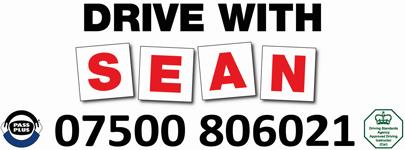The Tests
The theory, hazard perception and practical driving tests
Theory and hazard perception come first You need to pass your theory and hazard perception test at the same time before you can apply for your practical test. You do NOT however, need to have passed these before taking lessons. I will, as part of your training, help you prepare for the theory and hazard perception tests, and advise when you are ready to take them.
You will need a valid provisional driving licence to take your theory test and you can book your theory and hazard perception tests online, or by phone or by post.
The theory test is a 50-question multiple-choice test. To pass you must answer 43 or more questions correctly within 57 minutes. Questions are chosen at random from a bank of over 1,000 questions, and you answer by touching the screen. During the test you have the option to skip questions and return to them later. You can take a mock test online here.
How the hazard perception test works Immediately after your theory test, you’ll watch a series of 14 one-minute video clips, each showing potential hazards involving road conditions, pedestrians or road users.
There are 15 hazards to identify and you can score up to 5 points on each one, depending on how quickly you identify them. You need to score 44 out of 75 to pass – don’t worry it is not as tough as it sounds!
Then comes the practical test In your practical test, you have 40 minutes to demonstrate everything you have learned in your driving lessons. You need to show you can drive competently and safely in all kinds of driving situations. You’ll be asked to do two of the three reversing manoeuvres you’ve practised with your me, and possibly make an emergency stop. You’ll also answer two vehicle safety check questions, one ‘show me’ and one ‘tell me’.
To pass, you will have to complete the test with no serious faults, and you must have 15 or fewer minor errors.
During your test you wall also have to answer the Show Me – Tell Me Questions as below.
These are the Show Me questions
- When it’s safe to do so, can you show me how you wash and clean the rear windscreen?
- When it’s safe to do so, can you show me how you wash and clean the front windscreen?
- When it’s safe to do so, can you show me how you’d switch on your dipped headlights?
- When it’s safe to do so, can you show me how you’d set the rear demister?
- When it’s safe to do so, can you show me how you’d operate the horn?
- When it’s safe to do so, can you show me how you’d demist the front windscreen?
- When it’s safe to do so, can you show me how you’d open and close the side window?
These are the Tell Me questions
1. Tell me how you’d check that the brakes are working before starting a journey.
Brakes should not feel spongy or slack. Brakes should be tested as you set off. Vehicle should not pull to one side.
2. Tell me where you’d find the information for the recommended tyre pressures for this car and how tyre pressures should be checked.
Manufacturer’s guide, use a reliable pressure gauge, check and adjust pressures when tyres are cold, don’t forget spare tyre, remember to refit valve caps.
3. Tell me how you make sure your head restraint is correctly adjusted so it provides the best protection in the event of a crash.
The head restraint should be adjusted so the rigid part of the head restraint is at least as high as the eye or top of the ears, and as close to the back of the head as is comfortable. Note: Some restraints might not be adjustable.
4. Tell me how you’d check the tyres to ensure that they have sufficient tread depth and that their general condition is safe to use on the road.
No cuts and bulges, 1.6mm of tread depth across the central three-quarters of the breadth of the tyre, and around the entire outer circumference of the tyre.
5. Tell me how you’d check that the headlights and tail lights are working. You don’t need to exit the vehicle.
Explain you’d operate the switch (turn on ignition if necessary), then walk round vehicle (as this is a ‘tell me’ question, you don’t need to physically check the lights).
6. Tell me how you’d know if there was a problem with your anti-lock braking system.
Warning light should illuminate if there is a fault with the anti-lock braking system.
7. Tell me how you’d check the direction indicators are working. You don’t need to exit the vehicle.
Explain you’d operate the switch (turn on ignition if necessary), and then walk round vehicle (as this is a ‘tell me’ question, you don’t need to physically check the lights).
8. Tell me how you’d check the brake lights are working on this car.
Explain you’d operate the brake pedal, make use of reflections in windows or doors, or ask someone to help.
9. Tell me how you’d check the power-assisted steering is working before starting a journey.
If the steering becomes heavy, the system may not be working properly. Before starting a journey, 2 simple checks can be made.
Gentle pressure on the steering wheel, maintained while the engine is started, should result in a slight but noticeable movement as the system begins to operate. Alternatively turning the steering wheel just after moving off will give an immediate indication that the power assistance is functioning.
10. Tell me how you’d switch on the rear fog light(s) and explain when you’d use it/them. You don’t need to exit the vehicle.
Operate switch (turn on dipped headlights and ignition if necessary). Check warning light is on. Explain use.
11. Tell me how you switch your headlight from dipped to main beam and explain how you’d know the main beam is on.
Operate switch (with ignition or engine on if necessary), check with main beam warning light.
12. Open the bonnet and tell me how you’d check that the engine has sufficient oil.
Identify dipstick/oil level indicator, describe check of oil level against the minimum and maximum markers.
13. Open the bonnet and tell me how you’d check that the engine has sufficient engine coolant.
Identify high and low level markings on header tank where fitted or radiator filler cap, and describe how to top up to correct level.
14. Open the bonnet and tell me how you’d check that you have a safe level of hydraulic brake fluid.
Identify reservoir, check level against high and low markings.
Then comes the practical test. In your practical test, you have 40 minutes to demonstrate everything you have learned in your driving lessons. You need to show you can drive competently and safely in all kinds of driving situations. You’ll be asked to do one of the four reversing manoeuvres you’ve practised with me, and possibly make an emergency stop. You’ll also answer two vehicle safety check questions, one ‘show me’ and one ‘tell me’. Your practical driving test includes a section of ‘independent driving’. In this section of your test, you’ll be asked to drive for about 10 minutes without step by step route directions from your examiner.
Watch the DSA video explaining how the test works here.
Be prepared! To pass, you will have to complete the test with no serious faults, and you must have 15 or fewer minor errors.
The current national average practical pass rate is around 43%, so it makes sense to be as prepared as possible. I will advise you when you are ready for the practical test and help you understand the main reasons people fail.
- You’ll need to study ‘The Highway Code’, ‘Theory Test’ book and CD-ROM.
- If you fail your practical test, but pass your theory, you need only sit the practical next time.
- The combined theory and hazard perception test currently costs £23
- A weekday practical test costs £62 and an evening or weekend tests cost £75. Both of these will be plus lesson time.
- In addition, you are responsible for providing a car for the test. If you have lessons with me, my car will be available for the test if required and you will also need an hour’s lesson prior to the test itself.
IF USING YOUR OWN CAR FOR TEST: You don’t need any other documents (MoT, insurance etc) however YOU MUST PROVIDE A MIRROR FOR THE EXAMINERS USE and L plates front and back and check with your insurance company that your car is insured for use in the practical test.
Also make sure all the lights are working, especially the brake lights as the examiner may check them, and make sure the tyres have at least 1.6mm of tread and no damage to the wall of the tyres, and have the correct pressure. Check the DSA’s website to make sure your car has not been subject to any safety recalls, if so they will require written proof that any remedial action has been undertaken – click here to visit their list of cars affected.
Once you’ve passed Become a more confident driver with Pass Plus. You may save money on your insurance too, check with your insurance company.


